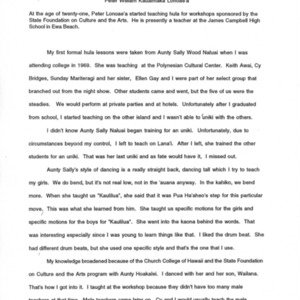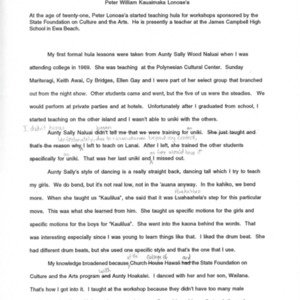Peter William Kauaimaka Lonoae‘a
Title
Peter William Kauaimaka Lonoae‘a
Subject
Nā Kumu Hula Peter William Kauaimaka Lonoae‘a - Nānā I Nā Loea Hula Volume 2 Page 68
Description
At the age of twenty-one, Peter Lonoae‘a started teaching hula through workshops sponsored by the State Foundation on Culture and the Arts, he is presently a teacher at the James Campbell High School in ‘Ewa Beach.
My first formal hula lessons were taken from Aunty Sally Wood Naluaʻi when I was attending college in 1969. She was teaching at the Polynesian Cultural Center. Keith Awai, Cy Bridges, Sunday Mariteragi and her sister Ellen Gay, and I were part of her select group that branched out from the night show. Other students came and went but the five of us were the steadies. Unfortunately after I graduated I left to teach school on Lānai. I didn’t know Aunty Sally would begin a training for an ‘ūniki. As fate would have it, that was her last ‘ūniki. I missed out.
Aunty Sally’s style of dancing is a really straight back and dancing tall style which I try to teach my girls. We do bend but it’s not real low, not in the ‘auana anyway. When she taught us “Kaulīlua,” she said that it was Pua Ha‘aheo’s step for this particular move. She taught us specific motions for the girls and specific motions for the boys for “Kaulīlua.” She went into the kaona behind the words. It was interesting to learn things like that especially since I was still young. She had different drum beats but she used one specific style and that’s the one that l use.
My knowledge broadened while attending the Church College of Hawaiʻi and when I participated in the State Foundation on Culture and the Arts program with Aunty Hoakalei Kamau‘u. I danced with her and her son Wailana. I taught at the workshop because they didn’t have too many male teachers at that time. Through these workshops l met other instructors like Aunty Eleanor Hiram Hoke, Uncle Henry Pa, and Lokalia Montgomery who I considered very interesting. It was a learning experience for me.
I was a traveling resource teacher for the Department of Education. In 1976 I taught hula kahiko for Aunty Elaine Ka‘ōpūiki on Lānai. After one year on Lānai l taught music and performing arts to preschoolers up to the seventh graders on Moloka‘i for four years. From Moloka‘i I went to Hana where I taught the intermediate and high school students for six years. In 1987 I returned to O‘ahu and have been teaching at James Campbell High School ever since.
My dancing style is a combination of Aunty Sally and John Kaʻimikaua. We wanted to perform Molokaʻi numbers at the Merrie Monarch Festival which were unique to Molokaʻi so we asked John Kaʻimikaua for chants. He introduced basic steps and I have incorporated some of his basic styles with the style that I already had. So it’s a mixture now.
The students who are in my class either come from a hālau or have no hula knowledge at all. They just come to my class thinking it’s an easy class. A lot of my former students asked me to start a class for them but I always told them that my classes were their jumping off point. I still tell them that after you see what I have to offer and you want more, then seek out other teachers.
I have never thought of opening a hālau because I did not ‘ūniki. I don’t feel proper. I do have hō'ike for my students. The requirements are almost the same. You have to create a chant, create motions, teach other students, and everything else except you will not ‘ūniki.
There are so many young kumu hula that I don’t even know their names. The only time I see them is at competitions. Although they have Hawaiian roots, not all of them are Hawaiian even the ones I consider real good. Some of them don’t even have an ounce of Hawaiian blood in them but they’re so into the culture that they I have adopted it and it has become a part of them.
My first formal hula lessons were taken from Aunty Sally Wood Naluaʻi when I was attending college in 1969. She was teaching at the Polynesian Cultural Center. Keith Awai, Cy Bridges, Sunday Mariteragi and her sister Ellen Gay, and I were part of her select group that branched out from the night show. Other students came and went but the five of us were the steadies. Unfortunately after I graduated I left to teach school on Lānai. I didn’t know Aunty Sally would begin a training for an ‘ūniki. As fate would have it, that was her last ‘ūniki. I missed out.
Aunty Sally’s style of dancing is a really straight back and dancing tall style which I try to teach my girls. We do bend but it’s not real low, not in the ‘auana anyway. When she taught us “Kaulīlua,” she said that it was Pua Ha‘aheo’s step for this particular move. She taught us specific motions for the girls and specific motions for the boys for “Kaulīlua.” She went into the kaona behind the words. It was interesting to learn things like that especially since I was still young. She had different drum beats but she used one specific style and that’s the one that l use.
My knowledge broadened while attending the Church College of Hawaiʻi and when I participated in the State Foundation on Culture and the Arts program with Aunty Hoakalei Kamau‘u. I danced with her and her son Wailana. I taught at the workshop because they didn’t have too many male teachers at that time. Through these workshops l met other instructors like Aunty Eleanor Hiram Hoke, Uncle Henry Pa, and Lokalia Montgomery who I considered very interesting. It was a learning experience for me.
I was a traveling resource teacher for the Department of Education. In 1976 I taught hula kahiko for Aunty Elaine Ka‘ōpūiki on Lānai. After one year on Lānai l taught music and performing arts to preschoolers up to the seventh graders on Moloka‘i for four years. From Moloka‘i I went to Hana where I taught the intermediate and high school students for six years. In 1987 I returned to O‘ahu and have been teaching at James Campbell High School ever since.
My dancing style is a combination of Aunty Sally and John Kaʻimikaua. We wanted to perform Molokaʻi numbers at the Merrie Monarch Festival which were unique to Molokaʻi so we asked John Kaʻimikaua for chants. He introduced basic steps and I have incorporated some of his basic styles with the style that I already had. So it’s a mixture now.
The students who are in my class either come from a hālau or have no hula knowledge at all. They just come to my class thinking it’s an easy class. A lot of my former students asked me to start a class for them but I always told them that my classes were their jumping off point. I still tell them that after you see what I have to offer and you want more, then seek out other teachers.
I have never thought of opening a hālau because I did not ‘ūniki. I don’t feel proper. I do have hō'ike for my students. The requirements are almost the same. You have to create a chant, create motions, teach other students, and everything else except you will not ‘ūniki.
There are so many young kumu hula that I don’t even know their names. The only time I see them is at competitions. Although they have Hawaiian roots, not all of them are Hawaiian even the ones I consider real good. Some of them don’t even have an ounce of Hawaiian blood in them but they’re so into the culture that they I have adopted it and it has become a part of them.
Citation
“Peter William Kauaimaka Lonoae‘a,” Nā Kumu Hula Archive, accessed July 12, 2025, https://nakumuhula.org/archive/items/show/132.






